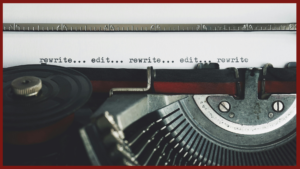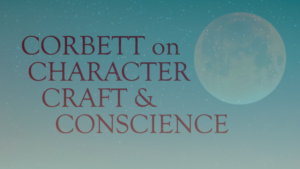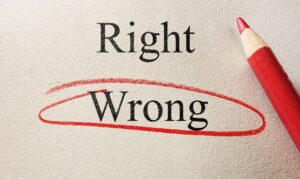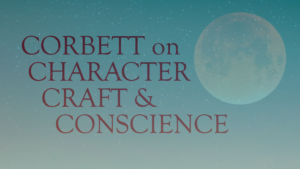Backstory
My dad, Grant Overstake, has written millions of sentences. As a former journalist, pastor, and now novelist, he’s got what the writing world considers “chops.” Big papers like the Miami Herald published his sports column for years, and small papers had his by-line on every article from op-eds to sports to obits.
His young adult sports novels are precise, beautiful, engaging. His sermons, spoken word he wrote to help rural Kansans navigate their faith journeys and complicated lives in the late 90s, were captivating, heart-felt, well-rounded. This man has done it all in the writing world — if I listed his awards, I’d reach my word-limit in this article.
I decided early in my life that I, too, would be a writer. If you’re a parent and you try to get your kid to find passion in the things you love, you likely will feel one of two things: the sting of rejection accompanying an eye-roll, or the wave of pride accompanying an attempt. My first attempt was verbal storytelling, just like my dad behind the pulpit. It turned into written storytelling as soon as I could hold a pen. Sign me up, Dad! I wanted to be like him.
Sometimes, a sign-me-up attitude can be intimidating as a parent. What if your child is no good? What if they’re not coachable? What if criticism of them is too much? I don’t know what form of bravery swept me as a child, but I showed my award-winning journalist father my first attempt at a novel, written in a wide-ruled spiral-bound notebook.
“Don’t overwrite,” he said. “Simplify it. Here, read this.” And he handed me Hemingway, Herman Hesse, and Rick Reilly.
In high school, he read my articles for the school paper and with his bracing, left-handed scrawl, edited with no hesitation. I remember, at first, that it stung. I might’ve cried. I was fifteen, learning from a master. I worked harder, read more closely, listened carefully. I built my words on the true stories from a small-town high school where football reigned supreme. In this world, the girls on the sidelines weren’t writing articles; they were dressed in cheer uniforms, caught up in the spectacle rather than the storytelling.
I donned a cheer uniform, too, and learned and listened to how sports were played. I wrote for myself, for my classes, for my newspaper, for essay contests. I sought my dad’s praise, his admiration, his subtle nod that affirmed I’d done it right. I won some of my own awards.
I had to learn, from an amazing writer, how to accept what a first draft is: each sentence might change. Bones are there, meat needs to fill in around it. Simpler is better. Red ink is strengthening your work. None of this is personal – these words are not tattooed on you. Nothing is permanent until the paper’s put to bed, kid. I remember the smell of newsprint, the dusting of ink on the sides of his hands, his press badge on the kitchen counter, his fingers calloused with the grip of a pencil.
I learned how to accept his red ink […]
Read MoreTherese here to introduce you to someone near and dear to me: my son, Liam. ❤️
Liam’s screenwriting journey started as a Rod Serling fan. Inspired by Serling’s allegorical storytelling, he attended USC’s film school where his thesis film, You Missed a Spot, was selected in over 30 festivals internationally. Since then, he has worked on the production-side of the industry, most recently wrapping as the line producer’s assistant on FX’s Mayans MC.
You may have heard about the downturn of work in Hollywood, and so Liam has bided his time between jobs doing something he was likely, inevitably, genetically born to do: WRITE. That the short story he’s written, that he’s now determined to see produced (see Kickstarter), taps into a real-life wound should come as no surprise to you, WU community.
But I’ll let Liam tell you about that, WU-style. Take it away, kiddo.
As writers, we often face the challenge of crafting stories that feel authentic, especially when venturing into experiences we haven’t lived ourselves. This was the case for me when I set out to write my new short film, Venus in Furs, a psychological thriller that personifies heroin as a woman.
I’m a filmmaker living in Los Angeles, and my life was deeply impacted when one of my close friends from film school overdosed on drugs laced with the powerful synthetic opioid, fentanyl. I remember the first time I met him—we were attending a mandatory lecture on the cinema and music of the 1960s. We were sitting on either side of another student we both had a crush on and got into a pointless debate about The Doors, as if this poor girl remotely cared about some band from five decades ago. He demolished me in the debate. The guy was like Jim Morrison himself—long-haired, charismatic as hell, with a ribcage you could practically see through his t-shirt.
After the girl successfully escaped, the two of us grabbed lunch and admitted we were only trying to impress her. Instant friendship.
During lunch, our conversation abruptly ended when he mentioned he was going to leave to smoke some opium. I assumed he was joking at the time—I mean, I had just met the guy. What, opium? You mean that shit from the 1800s? But over time, I came to learn that he was affected by a powerful addiction that, to him, wasn’t some unshakable affliction as often depicted, but rather the means to radically take hold of his post-high-school freedom and live out the fantasy of the rock ’n’ roll lifestyle he so loved.
The last time I saw him, I visited his three-bedroom high-rise in Downtown Los Angeles, full of vintage records and a collection of Les Pauls paid for with credit cards he couldn’t pay off. It was the Fourth of July, and he was excited to launch fireworks at passing cars. At that point, I had witnessed the drug obliterate his ambitions. He had stopped attending classes, gained weight, and lost that magic spark that drew me to him in the first place. Heroin took everything from him. And yet he was so happy to participate in his own self destruction. In fact, sitting there with all his guitars and […]
Read MoreI’ve just come back from a wonderful month-long trip to France to visit family and gather material for a new book within my Paris series of adult novels. Written under the name of Sophie Beaumont, the first of these, The Paris Cooking School, came out in Australia last year and is to appear in North America this August. (The second one, A Secret Garden in Paris, comes out in Australia this November). And whilst I went to France with ideas already for what this new, third novel was going to be about, with clear ideas of what I needed to visit for my research, the trip also showed me a number of unexpected threads which will greatly strengthen the original idea and enrich the story. That got me thinking about how you always have to be open to the unexpected, not only when you are in the early stages of planning, as I am now, but also further along. In the early stages of planning and research, to be in the place where you plan to set the story will often offer that unexpected turn. All the reading in the world about a place doesn’t necessarily give you the full picture; you might miss little details that can act as catalysts for scenes or developments in the story. Later, sticking too close to your original plan can also mean you miss out on an interesting twist or a new direction your character might go in.
In my case, as it was at such an early stage, I had only vague ideas as to what my characters might do for a living. Being close to my family members and sharing their lives for a while inspired me in unexpected ways. Watching two of my sisters work at their brocante stands (brocante is kind of second-hand antiques, and brocante fairs are hugely popular, regularly held events in France) gave me an unexpected idea for how part of my central intrigue might work in an immediately satisfying sort of way. Seeing my niece work on an assignment for her couture school in Paris sparked off another notion. Visiting the old, but still-exisiting, art school my grandmother had once attended gave me an idea for setting because of its position in the street in which it’s situated. Although I’d seen it on Google street view, the perspective an actual visit gave me, and walking the street itself in the company of another of my sisters, was enough to develop images that will help to make that setting even more solid. I expect that as I begin to get into the story, other things I’ve seen or experienced during that month, even if they have little initial or apparent relevance to the theme of my story, may pop up as either small insights or more important plot points. And I’m open to that, at least up to a point.
Because of course you can also destabilize a story by allowing the unexpected to completely take over; so you need to be aware of when that might happen. In my experience, this is especially marked around characterization, especially in taking the decision to add or delete a minor character because of an unexpected […]
Read MoreSylvia Plath’s grave, photo by author
In mid-January 2023, I flew to Manchester, England on my own, then found my way to a train station, the ticket office, and the correct track. Did you know that the lock for UK traincar bathrooms is cleverly hidden and NOT ON THE DOOR? Well, after one episode, you will remember that, trust me. The train delivered me, after several delays and transfers, to West Yorkshire. I arrived in the early afternoon and, with jet lag and a cast on my wrist, rolled my carry-on along a canal, past house barges, through a winter-quiet park and into the charming village of Hebden Bridge. If you watched the British series Happy Valley, you can picture it. I had lunch and left my bag at a pub called The Shoulder of Mutton Inn, where Dachshunds in tiny tartan coats sat on barstools. I went in search of a wine shop. At about three o’clock, I took a cab from the village through the tinier, even-more-quaint village of Heptonstall. From the top of a snowy lane, the cab zigzagged down a very steep cobblestone drive where the driver made a seemingly impossible K turn and let me out. He remarked that he usually wouldn’t come down the drive in winter because of the treacherous ice.
Lumb Bank
The house, called Lumb Bank, is an 18th-century stone mill owner’s house that was once the home of the late British Poet Laureate, Ted Hughes. It overlooks bucolic pastures with grazing sheep, and is set in twenty acres of woodland. I would spend a week there with fellow writers and two instructors and the following week, I would move north to Scotland for another writing retreat with strangers. Over those weeks, I would meet and live with more than twenty writers.
Arvon is the British charity that runs Lumb Bank and a non-profit program that promotes creative writing with classes and retreats held at three country houses in England (the others are in Devon and Shropshire). The fees are affordable and they offer grants. The program I signed up for was for novel writers, and we had workshops with two British novelists and a mid-week visiting writer, who turned out to be Maddie Mortimer, wunderkind author of the fabulous Maps of Our Spectacular Bodies.
At Lumb Bank, our rooms were small and simple, bathrooms were shared, and we had to bring in firewood and coal and each had to help cook dinner for the group on one night. My room had a twin bed, a dresser, and a small desk in front of a drafty window overlooking a hillside populated with sheep. We went twenty-four hours with no heating when the boiler broke, and for one very cold night we stayed up late around the stone fireplace, drinking Scotch and reciting poetry. I don’t know any poems by heart, so instead, as the only American in the group, I read the opening paragraphs of F. Scott Fitzgerald’s This Side of Paradise.
On my cooking night, I was tasked with preparing a vegan chocolate cake, which I ruined […]
Read MoreOne of the kindest reviews I ever received on my writing was from a reader who said I had the gift of crafting stories within stories. The compliment gave me goosebumps, for it acknowledged a skill I hadn’t set out to master. Later, when an opportunity arose for me to ask what prompted the observation, the reviewer highlighted two examples. Both centered around a main character revealing an aspect of their lives to another character – the first sharing a family history, and the second opening up about a painful emotional wound.
At the time I pondered why those moments, introduced in dialogue, had left an impression. Both scenes had come naturally; the kind you picture clearly and transcribe to the page with minimal angst or later revision. And ever since, I have a heightened awareness when during written works or visual performances a character comes to the fore to share their own story. These are not soliloquies, which fell out of favor long ago, even on stage. But perhaps they serve a similar purpose, an opportunity to shine a light upon a single character as they speak their truth or define themselves in their own words, outside the established structure and rhythms of the narrative. Spoken aloud, in the character’s own voice, these stories within stories can create ripples in the primary storyline.
Clearly the idea captivates me, but it seems rarely studied as a technique like other aspects of writing craft. For that reason, I thought it might be a worthy exploration with my writing family, all of you at WU. To kick things off, here are a few of my thoughts on the power that can come from moments when you allow a character to steal the microphone for a few pages.
A Compelling Approach to Backstory
We have all seen the movie or read the tale – there are so many from which to choose – set in a dystopian future or a dilapidated boom town. Invariably, at some point the explanation comes, the why behind the collapse of what had once held such majesty. It’s the backstory dilemma writers strive to handle well, how to inform without dragging down the present action. Movies may get away with an introductory narration, a literal data dump of how to receive page one – “long ago, in a galaxy far, far away ….” You get the picture.
But contemporary novels are trickier. Some writers are skilled at employing internal monologues. I have used them myself, and sometimes they manage to escape the dreaded “gazing into the mirror” phenomenon. But even when handled with aplomb, they can become repetitive. If every new character spends a few minutes musing about their current predicament, or their past, tales will all too often land in a reader’s “maybe later” pile, if they get published at all.
That dynamic can change if, when the proper time arrives, the past comes alive through the eyes of a character. An elderly woman eking out an existence on a failing farm telling a beloved granddaughter about her own nuptials decades earlier, a longing evident in her voice, can provide a window to the past. The details she shares of that special day – the wine, the music, her mother’s blessing – all […]
Read MoreIn the late ‘70s, when I was a freshman at Indiana University in Bloomington, Indiana, a film crew descended upon our quirky little town to shoot a movie. At the time I believe it was called “Bambino,” but that would change. The movie focused on an annual bicycle race the university hosted, called the Little 500 (a reference to the famed Indianapolis 500, the big annual auto race held 50 miles to the north). The Little 500 was the event of the year for students and townspeople alike, and to this day it draws crowds of 25,000 whenever April rolls around.
When you live in smalltown central Indiana, it’s not every day that Hollywood comes calling, and both the city and the university greeted the film project with open arms. It was the talk of the town, and soon we began seeing sections of the campus and surrounding area cordoned off while a cafeteria, courtyard or local street was commandeered to film some scene.
What was the movie about? Nobody really knew, other than that the climactic moment would be a reenactment of our big bicycle race. And – most thrilling of all – there was an open call to attend said reenactment as an extra, since they needed the stadium in which the race was held to be full of people. As a bonus, they also needed a ton of competitive bike riders, and since my dormitory floor had a team that had qualified to compete in the real race, the guys on that team were hired to ride in the reenactment, while the rest of their loyal floormates fake-cheered them on from the stands, hoping to be captured forever on film.
Suffice to say, we were stoked.
It didn’t take long for some of the novelty to wear off. The film crew seemed to be everywhere, and they showed no signs of ever being done. It became tiresome to have to walk around to a rear entrance of an academic hall, because the front of the building was being used for some scene they were shooting.
Even more troubling, we began to notice what they were getting WRONG. We heard talk that the movie would highlight rivalries between students and “cutters” – a derogatory name the filmmakers were using for the local townspeople, harkening back to a bygone era when Bloomington was home to a large workforce of limestone cutters. The problem was, the limestone quarries had been closed for years, there was little or no actual rivalry, and nobody called them “cutters.” “Townies,” maybe. A few called them “stonies” (for “stone cutters”). But what was all this “cutters” nonsense? No, this did NOT bode well.
And then there were the race scenes. Despite the initial surge of interest, it quickly became evident that there was no way to actually fill the stadium where the race was being filmed day after day, because nowhere near enough people were showing up. So the film crew would direct us (yes, yours truly was in some of the crowd scenes) to all shuffle back and forth to different parts of the stadium and sit together in crowded clumps of people. After one shot was completed, we would be ushered to some other section of the stands, and […]
Read MoreI lost a beloved aunt during the pandemic, not from Covid itself (though it kept me from attending her bedside), but from a galloping neurologic illness. Later, when things opened up to the point her husband could conduct a celebration of life, I was honored to be asked to help eulogize her.
How do you condense the essence of a person into a few short minutes that will hopefully promote catharsis and healing in yourself and your fellow mourners?
While other eulogists spoke to my aunt’s professional accomplishments (considerable) and her social outreach (intergalactic), I was the relative who had known her the longest. I decided my role was to describe the arc of her larger life. Also, to make clear that the vital, conscientious and fiercely loving woman we all knew had been visible from her earliest years.
An Intersection with Fiction
Around the same time period, I was drafting a holiday romance that required me to level-up my characterization abilities, and it wasn’t going well.
Someone once said that there are only two major plot constructs in fiction: either a person goes on a journey or a stranger comes to town. Well, I realized that to that point, all the fiction I had published dealt with people on the move.
My first book involved a stowaway and an athlete-turned-tour guide who met on a cross-continental bus journey. The second, an employee on a compulsory business trip in Jamaica. My most recent, a woman who’d gone deep undercover, so that her every possession had been curated to hide her true identity.
This time around, however, I was bringing my heroine back to the Colorado location she had fled some five years previously. I had an entire small town to terraform and populate, plus the hero’s ranch to create and imbue with familial backstory. And all this vast white canvas was intimidating to the point of paralysis, mostly because I still didn’t have a handle on my main character. Should I craft a landscape to set her in, and see how that shaped her character, or should I do the reverse?
I really couldn’t see the path forward, and on top of my pandemic-engendered writing rustiness, it just all felt overwhelming.
Collision of Sentiment and the Novella
But what are eulogies if not, in essence, a character sketch, and the stories I chose to tell about my aunt, the highlight reels of her life where it intersected with mine? And so, somehow, with my writing and the celebration occurring in synchrony, glimmers of a useful characterization progress began to reveal themselves.
One universally resonant anecdote regarding my aunt had to do with her amazing hospitality skills. Nearly every year, she’d invite family and friends to a Christmas holiday feast. You’d enter an immaculate house—often freshly painted for the occasion—that was filled with delicious aromas, the buzz of happy conversation, and laughter. After an incredible meal, to which you were allowed to contribute a side dish—more to appease your sense of responsibility and allow you to feel comfortable than because she actually wanted help—she’d send you home with a platter of dessert she’d spent weeks making, though she never ate it herself.
Are you familiar with confetti squares? […]
Read MorePhoto by Hannah Van Houten. Used with permission.
My brother is a counselor. A very good one who won’t tell any of his clients’ stories, even when our dad asks him to strip all identifying features. Dad knows better, but he’s a curious man who’s never been afraid of hearing no (which made him a great entrepreneur). One night, after refusing to answer, my brother kept thinking about how he could honor our dad’s desire to connect with him about his work.
About an hour later, he told us about an image and a corresponding therapeutic technique he’s been using with clients who’ve experienced trauma and cannot directly address what happened to them. They’ve built up so much resistance that they shut down when they try to even name it. He’s given these patients this story:
As you’ve gone through your life, when you experienced something you couldn’t face, you went on, but to survive, you left your pre-trauma self on the side of the road and went on without them. You may have done this a number of times. Let’s invite those abandoned yous to sit around the table with us and talk.
His clients have found this gentle and poignant exercise helpful. They’re able to re-connect with the self/selves who experienced the trauma and begin to deal with their misbeliefs, their unhelpful coping strategies–even if they can’t say what happened to them.
Which made me think of our protagonists.
When building our characters, we usually identify a moment in their past that is the root of the problem that will be solved in the course of our story. Whether we call it the Origin Story, The Wound, a Marker Moment, or something else, we create a before/after: Before this, I believed X, but after I believed D. They build up layers of habits, beliefs, and self-talk to cope. It is the action of the story to get them to face the results of that moment.
Using my brother’s image, the protagonist abandons their old-self on the side of the road and goes on. Instead of a kind therapist guiding them to reconnect with their old-self, we nasty novelists devise conflict after conflict to force them to do what they need to do to become whole again. They might need to mourn, reveal magical thinking, correct misbeliefs, reclaim who they could have been all along, embrace their true nature, stand up to the people who fractured them, or something else. We create events and relationships that keep hauling that abandoned self/selves in front of our protagonist until they have to face it.
I’m currently writing an 11-year-old protagonist whose Origin Story takes place when he’s 8. The sweet kid who feels part of his family and is secure in his father’s love and respect is abandoned on the side of the road. The image of him standing there, watching fractured-Sam go on without him tugs at my heartstrings.
But it’s also helping me identify the coping mechanisms and misbeliefs fractured-Sam will turn to. And how the course of the story will force him to confront the injustice of that moment, correct his misbeliefs about himself, and comfort that abandoned-self.
Sometimes I get hung up on storytelling lingo. I’d written an Origin […]
Read MorePerhaps love is in the air. Or maybe it’s a rush to reclaim control as a new normal gradually emerges from the global pandemic. Whatever the reason, my partner and I have, after a lengthy gap, been invited to not one, but three weddings. And these are not modest gatherings either, but true destination weddings in exotic locales, the kind you see in movies. They will not be rushed potluck affairs held in the backyard of a distant cousin (not that those can’t be lovely too).
With a bit of budgetary juggling, we plan to attend them all. It is, after all, a blessing to celebrate with loved ones. It’s also an opportunity to meet new people and explore distant lands. As the first approaches, I’ve found myself pondering the whole endeavor. I think of the planning that goes into such events and the stresses that accompany even joyful occasions. Lately I’ve also been dissecting the ways “big events” fit into some of my favorite stories, and my own writings. I now notice when they appear in shows, noting how such scenes alter the narrative, even when tangential to primary or even secondary plotlines. Events like weddings, holidays, reunions, retirements, and funerals are a part of life and so it is only natural they should appear in our tales. Some may appear in your work in progress right now.
If there isn’t one, I am not advocating you plop a random celebration into your story. In a publishing world that demands killing your darlings, I would never suggest adding filler. Then again, entire libraries could be devoted only to stories centered around life’s festivities. Jane Austen novels might well be reduced to a stream of letters and diary entries if not for village balls and the occasional nuptials. These days, Hallmark devotes an entire season to stories of offspring returning home or flung to the wilds for some sugary holiday confection and ultimate enlightenment. People gobble them up like cookies, as do I.
But that is not what I’m talking about today. Instead, my premise is simple – it may prove wise to give extra scrutiny to milestone events already present in your narrative, for such occasions provide fertile ground to strengthen your story.
Let’s explore a few avenues for kicking your writing up a notch when it comes to the “big event” in your tale.
Revealing Character
Nothing highlights character more than an unrelenting spotlight. An event in your story can serve that purpose. Perhaps your shy protagonist is corralled into giving a speech at a milestone birthday of an aging parent, the one with which he’s never seen eye to eye. Perhaps your hero is marrying, and all eyes will be on her regardless of how much she prefers the shadows. Scenes like these provide an opportunity to delve into your characters, exploring their motivations and deepest fears. Chance encounters at events can also provide a natural entry point for crucial backstory, evoking past heartbreaks, unrequited loves, or long-simmering rivalries. Use the unique situation to help readers understand idiosyncrasies in your character’s personality, uncovering the roots of their sagging confidence or the source of their unvanquished optimism.
Think of the event as a fresh stage set, filled with new and possibly one-off […]
Read MoreA dear friend of mine is having her name changed today. After her 20-year marriage ended in divorce a year ago, she decided to go back to using her maiden name, and today is her day in court, where she’s making the change both legal and official.
It is a powerful gesture, in multiple ways. It excises the ex-husband’s name from her life, but it does even more. My friend’s maiden name happens to be a beautiful and poetic word, literally a word that many people love and even celebrate. Her ex-husband’s surname? Spoken aloud, it sounds more like a cross between a rare skin disease and a Taco Bell appetizer. (Okay, I might be a little biased on that front; I was never fond of the man. But I digress…)
In preparing for today, my friend learned (as countless women have learned when either starting or ending a marriage) that the process of getting one’s name changed can be quite the hassle. But in her case, it’s totally worth it. For her, it simultaneously represents both a return to who she was, and a new beginning. In short, she knows something that I want to remind you of today:
There is power in names. And we as writers should try to leverage that power.
I see a lot of writers going with character names that are rather… generic, if I’m being honest. And while those names might tick off all the boxes for being realistic, believable, and/or even period-correct, I don’t think that playing it safe like that is always the most compelling approach. So today I want to look at the greater impact you can evoke by making bolder choices with your names. But being an open-minded guy who can usually see both sides of an issue, I’ll also offer a couple of examples where seemingly generic names were the perfect choice. But let’s start on the non-generic side of things…
The good, the bad and the ugly
Many authors take advantage of the fact that some names just inherently sound good or bad. Hang on – let me clarify. I’m not saying the actual name sounds good or bad; I’m saying it makes the character sound like a good or bad person. While this is particularly prevalent in fantasy and graphic novels, a good- or bad-sounding name can really help establish a reader’s perception of your character in any genre.
Some names that “bring the good” include Aragorn, Atticus Finch, Forrest Gump, Frodo Baggins, Hermione Granger, Holly Golightly, Jack Ryan, Joe Christmas, Huckleberry Finn, Nero Wolfe, Oliver Twist, and Phileas Fogg – I’m sure I’ll think of three dozen better examples the moment this post is published.
By contrast, some names immediately give you bad vibes, letting you know all is not right with this particular character. I’m writing this paragraph on Valentine’s Day, and I doubt that back in elementary school any of us would have wanted to receive a Valentine from a member of this motley crew: Draco Lucius Malfoy, Cruella de Vil, Dracula, Madame Defarge, Hannibal Lecter, Lord Voldemort, Miranda Priestly, Severus Snape, Nurse Ratched, or Simon Legree. One could argue that some of these names are pretty heavy-handed. And yet, look at how successful those not-so-subtle names have been in entrenching […]
Read MoreThe actor Louise Fletcher passed away a few weeks ago (September 23rd), and though she had a career spanning over half a century, much of it in television, her signature role, the one for which she is most remembered, is that of Nurse Ratched in Milos Forman’s adaptation of the Ken Kesey novel One Flew Over the Cuckoo’s Nest.
Why is it that in a wide open field of other notable villains—Hannibal Lecter, Norman Bates, Francis Dolarhyde (the “Red Dragon”), Tom Ripley, Noah Cross—this gentile, soft-spoken nurse continues to represent a particularly insidious form of evil?
In a Vanity Fair profile written by Michael Shulman in 2018, Ms. Fletcher explained her unique approach to the role and shared some other insights into the making of the film. The article was at least in part prompted by news of an upcoming Netflix series, Ratched, based on the same character (Sarah Paulson serves in the series role),
The TV series purports to tell the story of how the title character came to become such an iconic embodiment of evil—i.e., it focuses entirely on events that took place before those depicted in the novel. That backstory, created entirely by the show’s writers, bears little resemblance to the character in Kesey’s novel.
To be fair, Louise Fletcher’s portrayal also differed significantly from how the character was presented in the novel, but the difference between her approach and that provided by the TV series is striking.
The TV series portrays Nurse Ratched as diabolically evil by nature—malformed by childhood trauma, hardened during service as a nurse in the Pacific theater during WW2, and progressively more unhinged as the series progresses—with the ultimate effect that of a meticulously crafted mask concealing the soul of a self-aware monster. (The TV series makes little attempt to restrain its over-the-top inclinations, to the point it often approaches grand guignol. Its showrunner, Ryan Murphy, lists American Horror Story and The Jeffrey Dahmer Story among his credits.)
The film, on the other hand, sought to temper the more exaggerated elements of the novel. Forman, a veteran of the Prague Spring and an important figure in the Czech New Wave, escaped Czechoslovakia after the Soviet invasion in 1968, saw in the novel an analogy to his own experience under totalitarianism. (Kesey wrote the novel as a critique of U.S. conformity in the aftermath of WW2.) With respect to the character in question, Forman said, “The Communist Party was my Nurse Ratched.”
Ms. Fletcher took a slightly different approach. Consumed by the Watergate hearings, she saw in Nurse Ratched a reflection of Nixon’s abuse of power, but both she and Forman knew playing the character as an idea wouldn’t work, just as they agreed the portrayal in the novel was cartoonish—in Ms. Fletcher’s words, “she’s got smoke coming out of her ears.” Instead, she focused on a simple human observation: Nurse Ratched is convinced she’s right.
She thought back to her childhood in Alabama and “the paternalistic way that people treat other people there … White people actually felt that the life they were creating was good for black people.” She saw how that dynamic translated to Nurse Ratched and the patients under her care. “They’re in this ward, she’s looking out for them, and they have […]
Read MoreLast month (“Explanation vs. Fascination—And a Woman in the Corner Opposite“) we explored how to use moments of helplessness to “look behind the curtain” of your characters. The context of that exploration was the need to make our characters fascinating by resisting the temptation to explain them.
But simply exploring moments in the past won’t by itself overcome the temptation to narrate those events in some form of flashback or backstory reveal. We need to take our exploration a step further by showing how those moments generate behavior.
Before we begin, though, take a moment to reflect on how you yourself deal with stress or conflict.
The psychologist Anna Freud referred to such patterns of behavior with the technical terms adaptations or defense mechanisms.
The novelist Elizabeth George (in her fiction guide Write Away) refers to this type of pattern of behavior the Pathological Maneuver. Personally, I love that term, not just because it’s more colorful. It reveals the fundamentally maladaptive nature of the behavior in question.
The maneuver is pathological because it demonstrates how the person is not dealing with the underlying emotion prompted by their experience of stress, conflict, judgment, and so on. And the episodes of helplessness we explored last week, especially those linked to fear, shame, guilt, betrayal, or loss are precisely moments characterized by stress, conflict, and judgment.
To see how such episodes generate habitual behavior—specifically, here, Pathological Maneuvers—consider these examples:
Read More





















